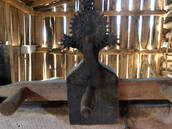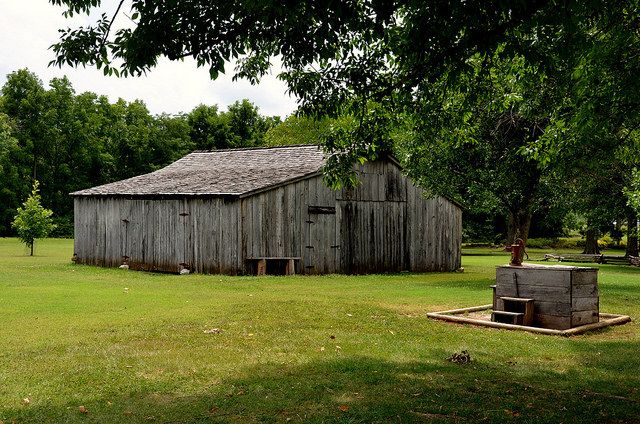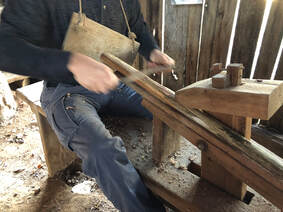Explore Our Buildings- Barn
Crib Barn
This Crib barn was on the Sanders farm in Hurley, MO. It was donated to us by Terry North. The barn is typical of the barns built in the Ozarks in the nineteenth century. When the barn was donated, the Sea Bees dismantled it and moved all the usable wood. Then Jeff Dykeman started the reconstruction, but the work called for more hands. A group of Amish workers from the Marshfield, MO area were hired to finish the building in the summer of 1991.
This barn has two unchinked log cribs to hold corn, hay or feed. Having the logs unchinked provides ventilation and prevented self combustion. The center of the barn is open at both ends, creating a breezeway so a wagon can drive through and unload the crops into the cribs both up high and down low. Our barn has six cribs. Two in the center for crops and the other four to be used for storage, livestock and a workshop.
This barn has two unchinked log cribs to hold corn, hay or feed. Having the logs unchinked provides ventilation and prevented self combustion. The center of the barn is open at both ends, creating a breezeway so a wagon can drive through and unload the crops into the cribs both up high and down low. Our barn has six cribs. Two in the center for crops and the other four to be used for storage, livestock and a workshop.
Springfield Wagon
Corn Hulling and Grinding
|
The corn huller, sometimes called corn sheller is a hand-cranked piece of machinery used to remove corn kernels from the cob. The kernels were then used to feed livestock, make corn meal, and other uses. The cob could then be used in the outhouse.
Once the corn kernels were removed from the cob they were placed in a grinder to make corn meal. The meal could be ground multiple times to gain a finer consistency. The meal could be used for cooking or in its finest state as a face powder. |
Wooden Farm Tools
|
Many tools around the farm were made from wood found on the farmers land. All parts of the trees were used from the trunks to the branches. Once the tree is felled or cut down as commonly referred, the branches are removed and it is time to take off the bark. A draw knife and shaving horse are traditional tools used for shaping wood. A piece of wood is secured in the shaving horse and the user pulls the blade across the wood and toward themselves. Used to make tool handles, furniture and more.
|
One tool made in this fashion is a rake. The uniqueness of this common farm tool is that it was created from a single piece of wood. The craftsmanship allowed for little to no waste.
|
Sharpening Stone and Anvil
Hand Pump

Water on the farm needs to come from underground wells.
Fortunately in the Ozarks there is ample source from underground
springs. A hand pump uses human power to force the water up
from the ground and into your bucket. Placement of your well and
outhouse are extremely important. You want to make sure
your outhouse is downstream from the well to
limit contamination of the water.
Small Animal Trap

Meat is sometimes hard to come by on the farm. Raising livestock is labor intensive, while preserving and storing meat presents many challenges. Trapping small animals can provide just enough meat on the table for dinner and animal pelts for use in clothing. One of the most common ways of trapping animals is the use of small animal traps or box traps. This task is often delegated to the children. Box traps are usually baited with food. There is a trigger in the back of the box which causes the door to shut trapping the animal inside. In the Ozarks box traps are used for catching squirrel, rabbit, fox or other small animals. Traps can be used for food, fur, pest control or wildlife management.
Rope Making Tool

Rope is made from long stringy fibrous material such as hemp or cotton
grown on the farm. These fibers are spun into yarn and then twisted or
laid into rope. The use of a rope making tool allows three strands of yarn
to be individually twisted in the same direction, then the tree strands are
twisted together in the opposite direction making an extremely strong rope.
grown on the farm. These fibers are spun into yarn and then twisted or
laid into rope. The use of a rope making tool allows three strands of yarn
to be individually twisted in the same direction, then the tree strands are
twisted together in the opposite direction making an extremely strong rope.







